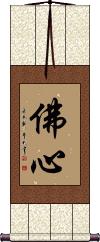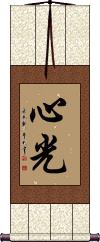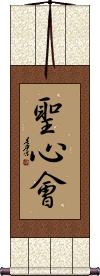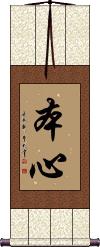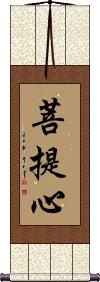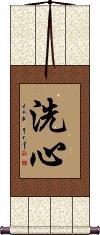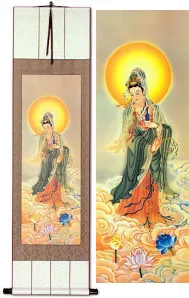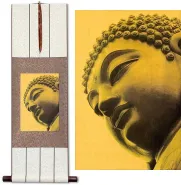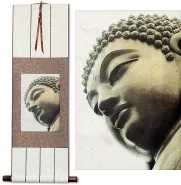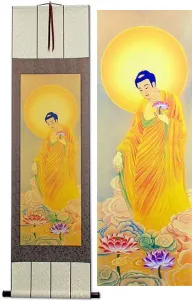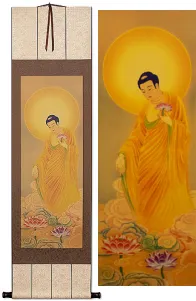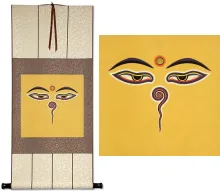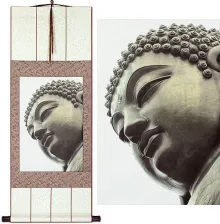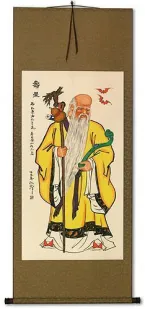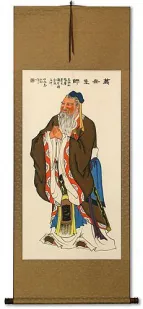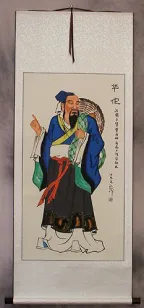Many custom options...
And formats...

Heart of the Buddha in Chinese / Japanese...
Buy a Heart of the Buddha calligraphy wall scroll here!
Personalize your custom “Heart of the Buddha” project by clicking the button next to your favorite “Heart of the Buddha” title below...
1. Buddha Heart / Mind of Buddha
2. Merciful Heart / The Light from a Buddha Mind
Buddha Heart / Mind of Buddha
佛心 means the Buddha's mind, Buddha-heart, or the spiritually enlightened heart/mind.
The Buddha Heart is detached from good and evil and other such constructs. The Buddha Heart has mercy, compassion, and loving-kindness for all sentient life, the good, the wicked, and all in between.
The heart and mind (心) are the same concepts in the ancient Orient, so you can use heart and mind interchangeably in this context.
Merciful Heart / The Light from a Buddha Mind
心光 can mean the light from a Buddha's mind or “merciful heart.”
This would especially be the light emanating from Amitābha.
Note that the character 心 can mean mind or heart. 光 means light or brightness - but in this context can suggest a glow of mercy or compassion.
This can also be a Japanese surname that is romanized as Shinkou or Shinko.
Seishin-Kai / Seishinkai
聖心会 is the Japanese martial arts title “Seishinkai” or “Seishin-Kai.”
It literally means “Sacred Heart Association” or “Pure-Heart Club.”
聖 can mean holy, sacred, saint, sage, virtuous, expert, wise and good, upright, or correct.
心 can mean heart, mind, center, core, spirit, soul, or vitality.
聖心 creates a word meaning sacred heart, or the holy mind (that of Buddha).
会 in Japanese means association, club, meeting, assembly, party, gathering, conference, athletic meet, or society.
The Original Mind
In Zen Buddhism, 本心 means “original mind” or “original heart,” which refers to one's Buddha-nature present from birth.
This can also be translated as true feelings, real intention, one's own heart, one's right mind, one's senses, one's conscience, or fundamental mind.
Note: 心 can mean heart or mind - thought in ancient Asia to be the same organ.
The Bodhi Mind
菩提心 means Bodhi-mind or Bodhi-heart.
This title represents the will to realize supreme enlightenment. The awakening of the Bodhi-mind is of utmost importance in Buddhist training.
Other definitions include the mind for or of bodhi, the awakened, enlightened mind, or having Buddha-nature.
Triple Truth of Japanese Buddhism
人間性を再生するのは寛容な心親切な言葉奉仕と思いやりの精神 is known as the Triple Truth of Buddhism in Japanese.
The Buddha ordered that all should know this triple truth...
A generous heart, kind speech, and a life of service and compassion are the things that renew humanity.
That is the English translation most commonly used for this Japanese Buddhist phrase. You might have seen this on a coffee cup or tee shirt.
Note: Because this selection contains some special Japanese Hiragana characters, it should be written by a Japanese calligrapher.
Purified Spirit / Enlightened Attitude
A Japanese martial arts title/concept
The first Kanji alone means to wash, bathe, primness, cleanse or purify.
The second Kanji means heart, mind, soul, or essence.
Together, these two Kanji create a word defined as “purified spirit” or “enlightened attitude” within Japanese martial arts.
洗心 is one of the five spirits of the warrior (budo) and is often used as a Japanese martial arts tenet. Under that context, it's often defined as a spirit that protects and harmonizes the universe. Senshin is a spirit of compassion that embraces and serves all humanity and whose function is to reconcile discord in the world. It holds all life to be sacred. It is the Buddha mind.
This title will only be familiar to Japanese who practice certain martial arts. Others may not recognize this word at all.
洗心 does not show up as a word in too many Chinese dictionaries, but it can be read and has the same meaning in Chinese.
![]() There is an issue with the first character. The original, and probably most correct version is shown above. However, many dojo documents and other sources have used a more simple first character. Arguments ensue about which version is correct. If you want to be correct in the Japanese language, use the "Select and Customize" button above. If you want to match the Kanji used by your dojo, click the Kanji shown to the right. There is a slightly different meaning with this first character which means before, ahead, previous, future, precedence.
There is an issue with the first character. The original, and probably most correct version is shown above. However, many dojo documents and other sources have used a more simple first character. Arguments ensue about which version is correct. If you want to be correct in the Japanese language, use the "Select and Customize" button above. If you want to match the Kanji used by your dojo, click the Kanji shown to the right. There is a slightly different meaning with this first character which means before, ahead, previous, future, precedence.
This in-stock artwork might be what you are looking for, and ships right away...
Gallery Price: $200.00
Your Price: $95.88
Gallery Price: $200.00
Your Price: $69.88
Gallery Price: $200.00
Your Price: $69.88
Gallery Price: $200.00
Your Price: $69.88
Gallery Price: $100.00
Your Price: $49.88
Gallery Price: $51.00
Your Price: $28.00
The Physician of Ancient China
Wall Scroll
Discounted Blemished
Gallery Price: $67.00
Your Price: $37.00
Not the results for heart of the buddha that you were looking for?
Below are some entries from our dictionary that may match your heart of the buddha search...
| Characters If shown, 2nd row is Simp. Chinese |
Pronunciation Romanization |
Simple Dictionary Definition |
佛心 see styles |
fó xīn fo2 xin1 fo hsin busshin |
More info & calligraphy: Buddha Heart / Mind of BuddhaThe mind of Buddha, the spiritually enlightened heart. A heart of mercy; a heart abiding in the real, not the seeming; detached from good and evil and other such contrasts. |
心光 see styles |
xīn guāng xin1 guang1 hsin kuang shinkou / shinko しんこう |
More info & calligraphy: Merciful Heart / The Light from a Buddha MindThe light from (a Buddha's) mind, or merciful heart, especially that of Amitābha. |
三毒 see styles |
sān dú san1 du2 san tu sandoku さんどく |
{Buddh} (See 煩悩・2) the three kleshas that poison the heart of man (desire, ill will and ignorance) The three poisons, also styled 三根; 三株; they are 貪 concupiscence, or wrong desire, 瞋 anger, hate, or resentment, and 痴 stupidity, ignorance, unintelligence, or unwillingness to accept Buddha-truth; these three are the source of all the passions and delusions. They represent in part the ideas of love, hate, and moral inertia. v. 智度論 19, 31. |
下種 下种 see styles |
xià zhǒng xia4 zhong3 hsia chung shimodane しもだね |
(adj-na,n,adj-no) (1) low-life; sleazebag; boor; (2) person of humble rank; humble person; peasant; menial; churl; petty official; (place-name) Shimodane To sow the seed; to preach, or teach. Tiantai defines three periods: (1) 種 when the seed of Buddha's teaching is sown in the heart; (2) 熟 when it ripens; (3) 脫 when it is stripped or harvested, i. e when one abandons all things. |
佛種 佛种 see styles |
fó zhǒng fo2 zhong3 fo chung busshu ぶっしゅ |
(1) (Buddhist term) seed of Buddhahood; (2) something that makes it possible to attain Buddhahood; (3) teaching of Buddha which make it possible to be enlightened The seed of Buddhahood; bodhisattva seeds which, sown in the heart of man, produce the Buddha fruit, enlightenment. |
四住 see styles |
sì zhù si4 zhu4 ssu chu shizumi しずみ |
(surname) Shizumi The four abodes or states in the 智度論 3, i. e. (1) 天住 the devalokas, equivalents of charity, morality, and goodness of heart; (2) 梵住 the brahmalokas, equivalents of benevolence, pity, joy, and indifference; (3) 聖住 the abode of śrāvakas, pratyekabuddhas, and bodhisattvas, equivalent of the samādhi of the immaterial realm, formless and still; (4) 佛住 the Buddha-abode, the equivalent of the samādhis of the infinite. v. 四住地. |
四等 see styles |
sì děng si4 deng3 ssu teng shitō |
The four virtues which a Buddha out of his infinite heart manifests equally to all; also called 四無量 q. w. They are: 慈悲喜捨 maitrī, karuṇā, muditā, upekṣā, i. e. kindness, pity, joy and indifference, or 護 protection. Another group is 字語法身, i. e. 字 that all Buddhas have the same title or titles; 語 speak the same language; 法 proclaim the same truth; and 身 have each the threefold body, or trikāya. A third group is 諸法 all things are equally included in the bhūtatathatā; 發心 the mind-nature being universal, its field of action is universal; 道等 the way or method is also universal; therefore 慈悲 the mercy (of the Buddhas) is universal for all. |
女人 see styles |
nǚ ren nu:3 ren5 nü jen nyonin; jojin にょにん; じょじん |
wife woman Woman, described in the Nirvāṇa sūtra 浬槃經 9 as the "abode of all evil", 一切女人皆是衆惡之所住處 The 智度論 14 says: 大火燒人是猶可近, 淸風無形是亦可捉, 蚖蛇含毒猶亦可觸, 女人之心不可得實 "Fierce fire that would burn men may yet be approached, clear breezes without form may yet be grasped, cobras that harbour poison may yet be touched, but a woman's heart is never to be relied upon." The Buddha ordered Ānanda: "Do not Look at a woman; if you must, then do not talk with her; if you must, then call on the Buddha with all your mind"— an evidently apocryphal statement of 文句 8. |
妙心 see styles |
miào xīn miao4 xin1 miao hsin myōshin |
The mind or heart wonderful and profound beyond human thought. According to Tiantai the 別教 limited this to the mind 眞心 of the Buddha, while the 圓教 universalized it to include the unenlightened heart 妄心 of all men. |
定水 see styles |
dìng shuǐ ding4 shui3 ting shui sadamizu さだみず |
(surname) Sadamizu Calm waters; quieting the waters of the heart (and so beholding the Buddha, as the moon is reflected in still water). |
心佛 see styles |
xīn fó xin1 fo2 hsin fo shinbutsu |
The Buddha within the heart: from mind is Buddha hood: the Buddha revealed in or to the mind; the mind is Buddha. 心佛及衆生, 是三無差別 The mind, Buddha, and all the living — there is no difference between the three. i. e. all are of the same order. This is an important doctrine of the 華嚴經 Huayan sutra, cf. its 夜摩天宮品; by Tiantai it is called 三法妙 the mystery of the three things. |
性心 see styles |
xìng xīn xing4 xin1 hsing hsin shōshin |
The perfectly clear and unsullied mind, i. e. the Buddha mind or heart. The Chan (Zen) school use 性心 or 心性 indifferently. |
慈雲 慈云 see styles |
cí yún ci2 yun2 tz`u yün tzu yün jiun じうん |
(given name) Jiun The over-spreading, fructifying cloud of compassion, the Buddha-heart; also Ciyun, the name of a noted Sung monk. |
本尊 see styles |
běn zūn ben3 zun1 pen tsun honzon ほんぞん |
(Buddhism) yidam (one's chosen meditational deity); the principal object of worship on a Buddhist altar; (of a monk who has the ability to appear in multiple places at the same time) the honored one himself (contrasted with his alternate forms, 分身[fen1 shen1]); (fig.) (jocular) the genuine article; the real McCoy; the man himself; the woman herself; the original manifestation of something (not a spin-off or a clone) (1) principal object of worship (at a Buddhist temple); principal image; (2) idol; icon; object of adoration; (3) (joc) (usu. as ご〜) the man himself; the person at the heart of the matter ? satyadevatā, 裟也地提嚩多. The original honoured one; the most honoured of all Buddhas; also the chief object of worship in a group; the specific Buddha, etc., being served. |
聖心 圣心 see styles |
shèng xīn sheng4 xin1 sheng hsin mimiko みみこ |
Sacred Heart (Christian) {Christn} Sacred Heart; (female given name) Mimiko The holy mind, that of Buddha. |
邪雲 邪云 see styles |
xié yún xie2 yun2 hsieh yün jaun |
Clouds of falsity or heterodoxy, which cover over the Buddha-nature in the heart. |
願心 愿心 see styles |
yuàn xīn yuan4 xin1 yüan hsin ganshin |
a wish; a request (to a deity) The heart of resolve (of Buddha to save all beings). |
ご本尊 see styles |
gohonzon ごほんぞん |
(1) principal object of worship at a temple (usu. a buddha or bodhisattva); principal image; idol; (2) (joc) the man himself; the person at the heart of the matter |
佛心印 see styles |
fó xīn yìn fo2 xin1 yin4 fo hsin yin busshin in |
The seal of the Buddha heart or mind, the stamp of the universal Buddha-heart in every one; the seal on a Buddha's heart, or breast; the svastika. |
佛心宗 see styles |
fó xīn zōng fo2 xin1 zong1 fo hsin tsung Busshin Shū |
The sect of the Buddha-heart, i.e. the Chan (Zen) or Intuitive sect of Bodhidharma, holding that each individual has direct access to Buddha through meditation. |
大乘心 see styles |
dà shèng xīn da4 sheng4 xin1 ta sheng hsin daijō shin |
The mind or heart of the Mahāyāna; seeking the mind of Buddha by means of Mahāyāna. |
御本尊 see styles |
gohonzon ごほんぞん |
(1) principal object of worship at a temple (usu. a buddha or bodhisattva); principal image; idol; (2) (joc) the man himself; the person at the heart of the matter |
無根信 无根信 see styles |
wú gēn xìn wu2 gen1 xin4 wu ken hsin mukon shin |
Faith produced not of oneself but by Buddha in the heart. |
胎藏界 see styles |
tāi zàng jiè tai1 zang4 jie4 t`ai tsang chieh tai tsang chieh taizō kai |
Garbhadhātu, or Garbhakośa-(dhātu), the womb treasury, the universal source from which all things are produced; the matrix; the embryo; likened to a womb in which all of a child is conceived— its body, mind, etc. It is container and content; it covers and nourishes; and is the source of all supply. It represents the 理性 fundamental nature, both material elements and pure bodhi, or wisdom in essence or purity; 理 being the garbhadhātu as fundamental wisdom, and 智 acquired wisdom or knowledge, the vajradhātu. It also represents the human heart in its innocence or pristine purity, which is considered as the source of all Buddha-pity and moral knowledge. And it indicates that from the central being in the maṇḍala, viz. the Sun as symbol of Vairocana, there issue all the other manifestations of wisdom and power, Buddhas, bodhisattvas, demons, etc. It is 本覺 original intellect, or the static intellectuality, in contrast with 始覺 intellection, the initial or dynamic intellectuality represented in the vajradhātu; hence it is the 因 cause and vajradhātu the 果 effect; though as both are a unity, the reverse may be the rule, the effect being also the cause; it is also likened to 利他 enriching others, as vajradhātu is to 自利 enriching self. Kōbō Daishi, founder of the Yoga or Shingon 眞言 School in Japan, adopted the representation of the ideas in maṇḍalas, or diagrams, as the best way of revealing the mystic doctrine to the ignorant. The garbhadhātu is the womb or treasury of all things, the universe; the 理 fundamental principle, the source; its symbols are a triangle on its base, and an open lotus as representing the sun and Vairocana. In Japan this maṇḍala is placed on the east, typifying the rising sun as source, or 理. The vajradhātu is placed west and represents 智 wisdom or knowledge as derived from 理 the underlying principle, but the two are essential one to the other, neither existing apart. The material and spiritual; wisdom-source and intelligence; essence and substance; and similar complementary ideas are thus portrayed; the garbhadhātu may be generally considered as the static and the vajradhātu as the dynamic categories, which are nevertheless a unity. The garbhadhātu is divided into 三部 three sections representing samādhi or quiescence, wisdom-store, and pity-store, or thought, knowledge, pity; one is called the Buddha-section, the others the Vajra and Lotus sections respectively; the three also typify vimokṣa, prajñā, and dharmakāya, or freedom, understanding, and spirituality. There are three heads of these sections, i. e. Vairocana, Vajrapāṇi, and Avalokiteśvara; each has a mother or source, e. g. Vairocana from Buddha's-eye; and each has a 明王 or emanation of protection against evil; also a śakti or female energy; a germ-letter, etc. The diagram of five Buddhas contains also four bodhisattvas, making nine in all, and there are altogether thirteen 大院 or great courts of various types of ideas, of varying numbers, generally spoken of as 414. Cf. 金剛界; 大日; 兩部. |
佛具十身 see styles |
fó jù shí shēn fo2 ju4 shi2 shen1 fo chü shih shen butsugu jūshin |
The ten perfect bodies or characteristics of Buddha: (1) 菩提身 Bodhi-body in possession of complete enlightenment. (2) 願身 Vow-body, i.e. the vow to be born in and from the Tuṣita heaven. (3) 化身 nirmāṇakāya, Buddha incarnate as a man. (4) 住持身 Buddha who still occupies his relics or what he has left behind on earth and thus upholds the dharma. (5) 相好莊嚴身 saṁbhogakāya, endowed with an idealized body with all Buddha marks and merits. (6) 勢力身 or 心佛 Power-body, embracing all with his heart of mercy. (7) 如意身 or 意生身 At will body, appearing according to wish or need. (8) 福德身 or 三昧身 samādhi body, or body of blessed virtue. (9) 智身 or 性佛 Wisdom-body, whose nature embraces all wisdom. (10) 法身 dharmakāya, the absolute Buddha, or essence of all life. |
佛心天子 see styles |
fó xīn tiān zǐ fo2 xin1 tian1 zi3 fo hsin t`ien tzu fo hsin tien tzu busshin tenshi |
The Son of Heaven of the Buddha-heart, a name given to Wudi of the Liang dynasty, A.D. 502-549. |
光明心殿 see styles |
guāng míng xīn diàn guang1 ming2 xin1 dian4 kuang ming hsin tien kōmyō shin den |
The temple of the bright or shining heart; the seat of Vairocana, the sun Buddha, in the Vajradhātu maṇḍala. |
十金剛心 十金刚心 see styles |
shí jīn gāng xīn shi2 jin1 gang1 xin1 shih chin kang hsin jū kongō shin |
Ten characteristics of the "diamond heart" as developed by bodhisattva: (1) complete insight into all truth; (2) saving of all creatures; (3) the glorifying of all Buddha-worlds; (4) supererogation of his good deeds; (5) service of all Buddhas; (6) realization of the truth of all Buddha-laws; (7) manifestation of all patience and endurance; (8) unflagging devotion to his vocation; (9) perfection of his work; (10) aiding all to fulfill their vows and accomplish their spiritual ends. 華嚴經 55. |
卽心念佛 see styles |
jí xīn niàn fó ji2 xin1 nian4 fo2 chi hsin nien fo sokushin nenbutsu |
To remember, or call upon, Amitābha Buddha within the heart, which is his Pure Land. |
口稱三昧 口称三昧 see styles |
kǒu chēng sān mèi kou3 cheng1 san1 mei4 k`ou ch`eng san mei kou cheng san mei kushō zanmai |
The samādhi in which with a quiet heart the individual repeats the name of Buddha, or the samādhi attained by such repetition. |
Click here for more heart of the buddha results from our dictionary
The following table may be helpful for those studying Chinese or Japanese...
| Title | Characters | Romaji (Romanized Japanese) | Various forms of Romanized Chinese | |
| Buddha Heart Mind of Buddha | 佛心 | busshin / bushin | fó xīn / fo2 xin1 / fo xin / foxin | fo hsin / fohsin |
| Merciful Heart The Light from a Buddha Mind | 心光 | shin kou / shinkou / shin ko | xīn guāng xin1 guang1 xin guang xinguang | hsin kuang hsinkuang |
| Seishin-Kai Seishinkai | 聖心会 / 聖心會 聖心会 | sei shin kai seishinkai | ||
| The Original Mind | 本心 | hon shin / honshin | běn xīn / ben3 xin1 / ben xin / benxin | pen hsin / penhsin |
| The Bodhi Mind | 菩提心 | bo dai shin bodaishin | pú tí xīn pu2 ti2 xin1 pu ti xin putixin | p`u t`i hsin putihsin pu ti hsin |
| Triple Truth of Japanese Buddhism | 人間性を再生するのは寛容な心親切な言葉奉仕と思いやりの精神 | ningensei o saisei suruno wa kanyou na kokoro shinsetsu na kotoba houshi to omoi yari no seishin ningensei o saisei suruno wa kanyo na kokoro shinsetsu na kotoba hoshi to omoi yari no seishin | ||
| Purified Spirit Enlightened Attitude | 洗心 先心 | sen shin / senshin | xǐ xīn / xi3 xin1 / xi xin / xixin | hsi hsin / hsihsin |
| In some entries above you will see that characters have different versions above and below a line. In these cases, the characters above the line are Traditional Chinese, while the ones below are Simplified Chinese. | ||||
Successful Chinese Character and Japanese Kanji calligraphy searches within the last few hours...
